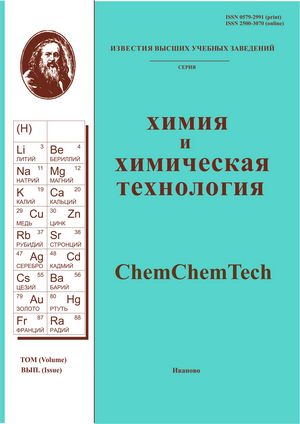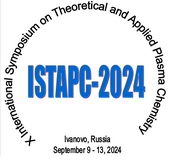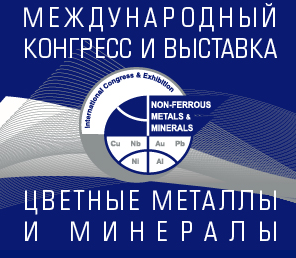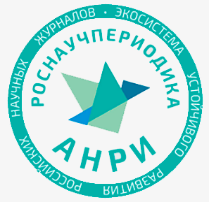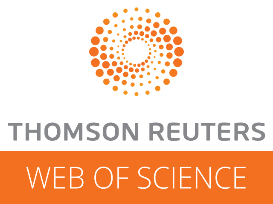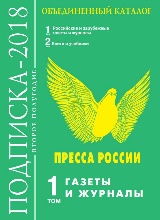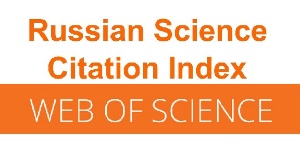ПЛАЗМА-РАСТВОРНЫЙ СИНТЕЗ ОКСИДА ЖЕЛЕЗА (III)
Аннотация
The process of formation of insoluble iron compounds, initiated by the action of a direct current discharge of atmospheric pressure in air on an aqueous solution of iron (III) sulfate, has been investigated. It was found that when the solution is the anode, the action of the discharge leads to the formation of a colloidal solution of iron hydroxosulfates and iron hydroxide. The colloidal solution, as shown by the DLS method, consists of two fractions 47 nm (73%) and 950 nm in size. The kinetics of the formation of colloidal particles was investigated by the turbodimetric method. It turned out that the rate of formation increases with an increase in the discharge current from 30 to 70 mA. At concentrations of iron (III) sulfate 5 mmol/l the rate constant of the process increases from 7∙10-3 to 2.2∙10-2 s-1. When this solution is destroyed, a precipitate of the corresponding compounds is formed. X-ray analysis showed that the precipitate is amorphous. The resulting precipitate, as shown by SEM, has a dense structure. The particle size is 100 nm on average. As a result of calcining the precipitate, as shown by X-ray analysis and EDX, it turns into crystalline iron (III) oxide of the trigonal system (hematite). The resulting oxide powder has a developed surface, with a particle size of less than 50 nm on average.
Литература
Wang C., Diamon H., Sun S. Dumbbell-like Pt−Fe3O4 Na-noparticles and Their Enhanced Catalysis for Oxygen Reduction Reaction. Nano Lett. 2009. V. 9. N 4. P. 1493-1496. DOI: 10.1021/nl8034724.
Apostolescu N., Geiger B., Hizbullah K., Jan M.T., Kureti S., Reichert D., Schott F., Weisweiler W. Selective catalytic reduction of nitrogen oxides by ammonia on iron oxide catalysts. Appl. Catal. B: Environ. 2001. V. 62. N 1-2. P. 104-114. DOI: 10.1016/j.apcatb.2005.07.004.
Sreeram K.J., Indumathy R., Rajaram A., Nair B.U., Ramasami T. Template synthesis of highly crystalline and monodisperse iron oxide pigments of nanosize. Mater. Res. Bull. 2006. V. 41. N 10. P. 1875-1881. DOI: 10.1016/j.materresbull.2006.03.017.
Chen Q., Li J., Li Y. A review of plasma–liquid interactions for nanomaterial synthesis. J. Phys. D: Appl. Phys. 2015. V. 48. N 28. P. 424005. DOI: 10.1088/0022-3727/48/42/424005.
Saito G., Akiyama T. Nanomaterial Synthesis Using Plasma Generation in Liquid 20. J. Nanomater. 2015. Article ID 123696. DOI: 10.1155/2015/123696.
Shutov D.A., Rybkin V.V., Ivanov A.N., Smirnova K.V. Synthesis of Zinc Oxide Powders in Plasma–Solution Sys-tems. High Energ. Chem. 2017. V. 51. N 1. P. 65-69. DOI: 10.1134/S0018143917010118.
Shutov D.A., Smirnova K.V., Gromov M.V., Rybkin V.V., Ivanov A.N. Synthesis of CdO Ultradisperse Powders Using Atmospheric Pressure Glow Discharge in Contact With Solution and the Investigation of Intermediate Products. Plasma Chem. Plasma Process. 2018. V. 38. N 1. P. 107-121. DOI: 10.1007/s11090-017-9856-0.
Shutov D.A., Sungurova A.V., Smirnova K.V., Manukyan A.S., Rybkin V.V. Oxidative-reducing processes with participation of manganese ions initiated by electric discharge in aqueous solution. ChemChemTech [Izv. Vyssh. Uchebn. Zaved. Khim. Khim. Tekhnol.]. 2018. V. 61. N 9-10. P. 24-30. DOI: 10.6060/ivkkt20186109-10.5802.
Tochikubo F., Shirai N., Uchida S. Liquid-phase reactions induced by atmospheric pressure glow discharge with liquid electrode. J. Phys: Conf. Ser. 2014. V. 565. P. 12010. DOI: 10.1088/1742-6596/565/1/012010.
Khlyustova A., Sirotkin N., Titov V. Plasma‐induced pre-cipitation of metal ions in aqueous solutions. J. Chem. Technol. Biotechnol. 2019. V. 94. N 12. P. 3987-3992. DOI: 10.1002/jctb.6204.
Shutov D.A., Ivanov A.N., Rakovskaya A.V., Smirnova K.V., Manukyan A.S., Rybkin V.V. Synthesis of oxygen-containing iron powders and water purification from iron ions by glow discharge of atmospheric pressure in contact with the solution. J. Phys. D: Appl. Phys. 2020. V. 53. N 28. P. 445202. DOI: 10.1088/1361-6463/aba4d7.
Altomare A., Corriero N., Cuocci C., Falcicchio A., Moliterni A., Rizzi R. QUALX2.0: a qualitative phase analy-sis software using the freely available database POW_COD. J. Appl. Cryst. 2015. V. 48. N 2. P. 598-603. DOI: 10.1107/S1600576715002319.
Grazulis S., Daskevic A., Merkys A., Chateigner D., Lut-terotti L., Quiros M., Serebryanaya N.R., Moeck P., Downs R.T., LeBail A. Crystallography Open Database (COD): an open-access collection of crystal structures and platform for world-wide collaboration. Nucl. Acids. Res. 2012. V. 40. N D1. P. D420-427. DOI: 10.1093/nar/gkr900.
Goronovsky I.T., Nazarenko Yu.P., Nekryach E.F. A short guide to chemistry. Kiev: Naukova Dumka. 1987. 828 p. (in Russian).
Pauling L., Hendricks S.B. The crystal structures of hematite and corundum. J. Am. Chem. Soc. 1925. V. 47. N 3. P. 781-790. DOI: 10.1021/ja01680a027.
Ivanov A.N., Shutov D.A., Manukyan A.S., Rybkin V.V. Influence of Non‑uniformity of Generation of Active Particles on Deposition Processes and Redox Reactions in a Glow Discharge in Contact with Water. Plasma Chem. Plasma Process. 2019. V. 39. N 1. P. 63-73. DOI: 10.1007/s11090-018-9936-9.
Witzke M., Rumbach P., Go D.B., Sankaran R.M. Evidence for the electrolysis of water by atmospheric-pressure plasmas formed at the surface of aqueous solutions. J. Phys. D: Appl. Phys. 2012. V. 45. N 7. P. 442001. DOI: 10.1088/0022-3727/45/44/442001.
Rumbach P., Bartels D.M., Sankaran R.M., Go D.B. The solvation of electrons by an atmospheric-pressure plasma. Nat. Comm. 2015. V. 6. P. 7248. DOI: 10.1038/ncomms8248.
Rumbach P., Bartels D.M., Go D.B. The penetration and concentration of solvated electrons and hydroxyl radicals at a plasma-liquid interface. Plasma Sours. Sci. Technol. 2018. V. 27. N 11. P. 115013. DOI: 10.1088/1361-6595/aaed07.

